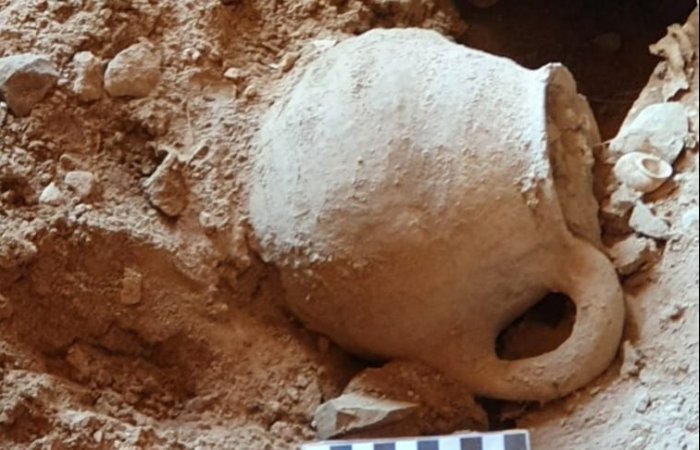Conny Waters - AncientPages.com - Cave 53, in the Qumran region delivers new surprises. A whole pottery vessel from the Early Bronze Age, one of the few ever discovered in the Judean Desert, was unexpectedly uncovered by a tourist in the cave!
An American tourist named Robbie Brown and his friends climbed into a cave located 100 m above the road line.
Sherds of jars and bowls that served as lids for jars, dates and olive seeds, and even a piece of an ancient scroll that did not contain writing. Image credit: Photo: Amir Ganor, Israel Antiquities Authority
Brown asked to show his friends an archeological dig in which he participated five years ago. The excavation was conducted by Dr. Oren Gottfeld of the Hebrew University of Jerusalem and Dr. Randall Price of the University of Liberty in Virginia.
It revealed fascinating findings: sherds of jars and bowls that served as lids for jars, dates and olive seeds, and even a piece of an ancient scroll that did not contain writing.
These findings surprised archaeologists because a previous excavation had already been conducted in the cave about 30 years ago.
In "Operation Scroll" initiated by the Israel Antiquities Authority and led by Dr. Yigal Israel and the late Dr. Rudolf Cohen, relics from the Neolithic to Roman periods were found by archaeologists.
Image credit: Israel Antiquities Authority
Allegedly, the completion of the excavation in 2017 was supposed to be the end of the cave study. But last week, Robbie and his friends entered the cave, and immediately, right in front of them, lay an ancient pottery jug, which the human eye had not seen for 5,000 years.
They photographed the jug - without touching it - and contacted Dr. Yuval Baruch from the Israel Antiquities Authority, who updated Amir Ganor, the IAA'S director of the robbery prevention unit. Ganor and Dr. Oren Gutfeld, the cave researcher, hurried out to the area.
They went up to the cave together with Aviam Atar, the Nature and Parks Authority district director, and immediately saw the jug.
"It's amazing," says Amir Ganor, "Only about two years ago, our archaeologists surveyed the cave as part of a survey of the Judean Desert caves, which has been conducted continuously for the past five years and was intended to document and locate all ancient finds in the desert caves. In a few caves, pottery sherds were found, providing evidence of the Early Bronze Age. This is perhaps the first complete vessel we have found from this period in the caves in the Judean Desert."
"It is good that the person who entered the cave was Robbie, who participated in the excavation and is aware of the importance of the finds and their role in completing the archeological puzzle of the Land of Israel," says Ganor. "We call on citizens who discover artifacts to leave them in place and call us immediately so that we can maximize the archaeological information from the find.”
The clay jug was removed from the cave and will be scientifically analyzed and published by the cave researcher, Dr. Oren Gottfeld.
It is important to know that traveling in the Judean Desert in the area of the cliffs is dangerous and prohibited by law. Protected animal species live in the nature reserve, and there is a great danger of falling rocks and falling off the cliffs, so the general public is asked to avoid walking on the cliffs themselves and in the caves in the desert.
